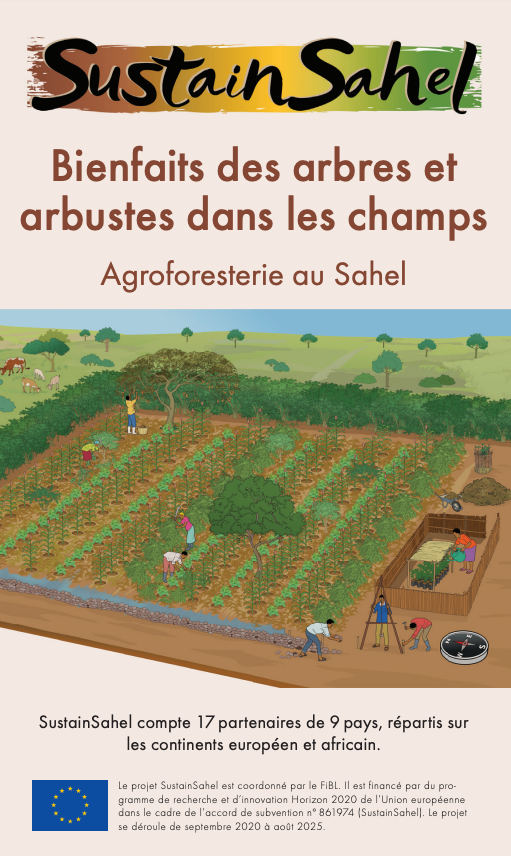Agroforestry can offer multiple benefits to farmers in the Sahelian region, notably by improving soil quality and increasing agricultural productivity.
The latest SustainSahel publications, a flyer and two corresponding videos, feature an example system that aims to show the benefits of trees and shrubs in agricultural practices, highlighting specific tree and shrub species, as well as agroforestry best practices.
Flyer
The flyer "Benefits of trees and shrubs in the field - Agroforestry in the Sahel" highlights the many advantages of incorporating trees and shrubs into agricultural practices, particularly in arid regions, to improve soil quality, enhance crop yields, and combat desertification.
Check out all SustainSahel publications here.
Videos
The first video: Advantages of agroforestry in the Sahel
This video highlights the advantages of agroforestry in the Sahel and explains how trees and shrubs can improve soil health and increase crop yields.
The video's key points are as follows:
- Leaving trees and shrubs in place instead of burning them protects the soil from degradation and erosion, and enriches the soil.
- Agroforestry, which integrates trees and shrubs into fields, has many benefits, including increased rainfall, provision of produce for sale and consumption, shade during the hot season, and availability of fodder during the dry season.
- Certain shrubs and trees, such as Gliricidia, Acacia albidia, Acacia rajana, and Piliostigma, are particularly beneficial for the Saelian zone.
- Recommended best practices include planting trees in rows, protecting them from animals in the first few years, and creating stone cordons to collect rainwater.
- The use of oseil to collect rainwater and the maintenance of nurseries are also mentioned as beneficial practices.
The second video: An example of an agroforestry farm in the Sahel
This video discusses agroforestry in the Sahel region and its benefits. Agroforestry involves integrating trees and bushes into agricultural fields. The video highlights several advantages of incorporating trees into crop fields, such as increasing yields by 100-800% in arid regions like the Sahel.
It then focuses on a specific example farm where various agroforestry practices are implemented:
- The farmers, Adya and Mousa, grow sorghum and intercrop it with cowpea (nibé), which enriches the soil with nitrogen and provides both food and income for the farmers.
- Gliricidia shrubs are planted alongside cowpea and sorghum to provide nitrogen to the sorghum.
- Guiera shrubs capture groundwater and improve soil structure during the dry season, and their leaves can be used to feed animals.
- A living fence made of Piliostigma shrubs protects the farm from animals and offers additional animal feed.
- Existing trees like the shea tree (karité) and Acacia albida are preserved and provide valuable resources.
- Tree roots play a crucial role in soil erosion prevention and water retention during the rainy season.
Check out all SustainSahel Audio-visual material here.
Further information
Weblinks
Youtube.com
Zenodo.org: Flyer Benefits of trees and shrubs in the field - Agroforestry in the Sahel

 tap and then scroll down to the Add to Home Screen command.
tap and then scroll down to the Add to Home Screen command.